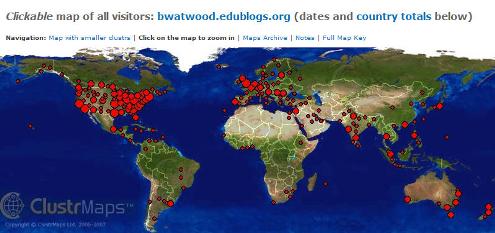There was an interesting point raised by one of my VIF students in our online class taught by Jon Becker and myself this weekend. Half of our online class are Visiting International Faculty studying for their Masters in Education here at VCU, and half are Virginia teachers studying in our Ed Leadership graduate program.
When I first arrived from Mexico to teach here, it was very noticeable for me to see that students here are more used to that kind of fast, graphic and entertaining way of displaying information or teaching and it took me some time to adapt to those “new students’ needs”. Here I have been in the process of becoming a digital resident.
I think that in developing countries, this change is happening but at a much slower pace because of the differences in access to the internet, just by looking at your ‘ClustrMap’ (in your Blog) and the red dots representing the access numbers from different countries, I could realize the way many countries are so far behind in terms of Web 2.0 tools usage.
I have been looking at the ClustrMap and seeing the connections spanning the continents. He looked at the same map and saw the missing opportunities being illustrated by the sparseness of some of the dots.
This is one of the reasons I enjoy working with international faculty. They help ground me in some fundamental truths. Friedman, Shirky, and Weinberger have all pointed to the democratization afforded by the web. All true, but evolving slowly and not there yet.

![Reblog this post [with Zemanta]](http://img.zemanta.com/reblog_e.png?x-id=70376328-2530-40f9-b86d-1b52e9a0cd80)
Hi Britt,
I think that this clustr map elucidates a situation appropriated to English speaking countries.
In my class blog, there are plenty of red dots on Brazil.
My point is that it’s not enough to be web 2.0 active, we must also know to read and write in English to go actually “global”.
I see my students struggling with google translator to communicate with their new English speaking friends; if the original message isn’t perfectly written, the automate translation will fail. I imagine that’s a problem too for all those countries with educational needs.
Ines